We all remember MacGyver. He’d had a toothpick and a piece of thread and voila, he’s create a rocket launcher out of it. Far-fetched and fun. Well there are a lot of very clever and inventive Critical Care docs out there, who have invented a lot of stuff, primarily for treating the hypoxic covid-19 patient. They range from ways to make delivering oxygen safer to creating CPAP devices where there are no CPAP machines. Here is a brief look at what’s out there. You might want to use some of this. Let me know if you have any of your own.
Oxygenation
There is very little evidence on the clear demarcation of oxygen delivery systems produce droplets vs aerosols. We consider any flow above 6L as being high flow.
The progression of oxygenation in my institution is:
- Nasal canal from 1-4L/min(perhaps 6L if the patient can tolerate), with surgical mask over.
- The next step is Hudson mask at 6-8 L/min, with a surgical mask over it, and then we progress to
- A non-rebreather at 15L/min with a surgical mask over the mask
The surgical mask decreases the flow of expired air out of the exhalation holes through the mask.
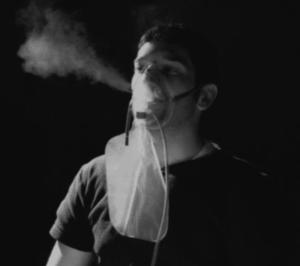
Many of you would have seen the images out there about the amount of exhaled content through the exhalation ports of the standard oxygen mask. Here is one from a previous post.
What if we can minimise the flow out of the mask?
The non-rebreather has a valve into the bag, making it a NON-rebreather. What if we could pump the air in at high FiO2 and have the exhaled air out filtered?
Below is a quick contraption I put together to allow that. The key in all of these, is to think about where the filter goes.
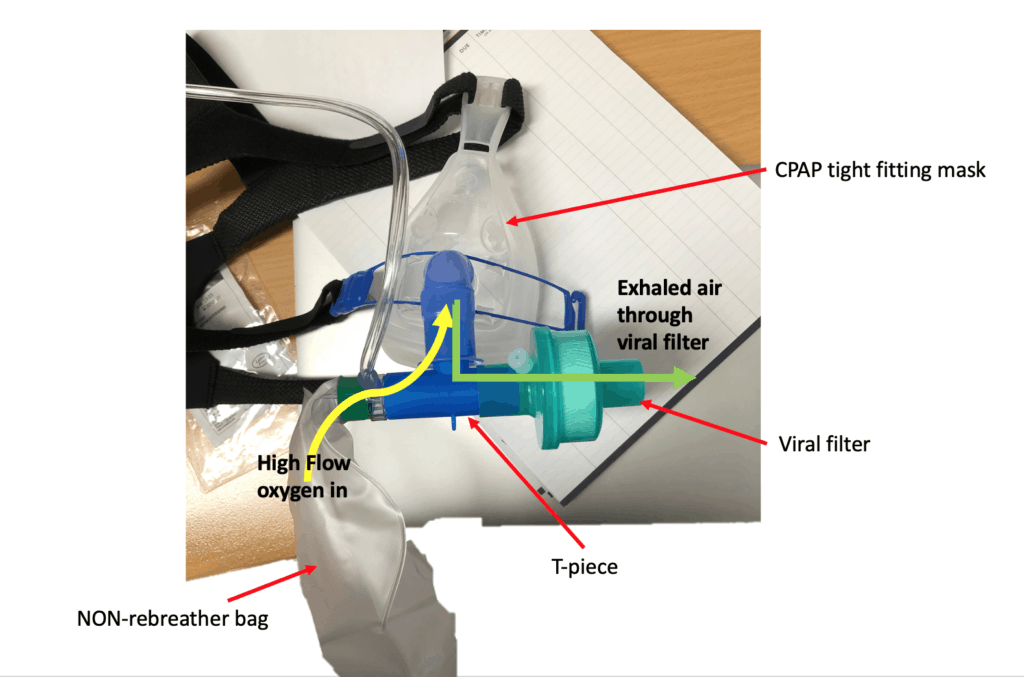
Creating CPAP
There are a lot of MacGyvered sets out there. One of my favourites is EMCrit’s set up, that generates up to 15cm of PEEP. As always the mask is difficult to keep on these patients if they are short of breath. A little ketamine may help.
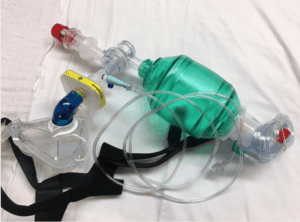
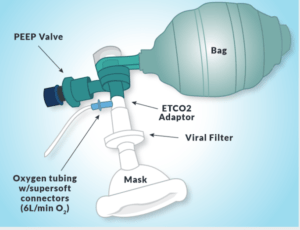
Again, the filter should be closest to the patient ie., right after the mask.
Here is video of the setup.
We had our version of this:
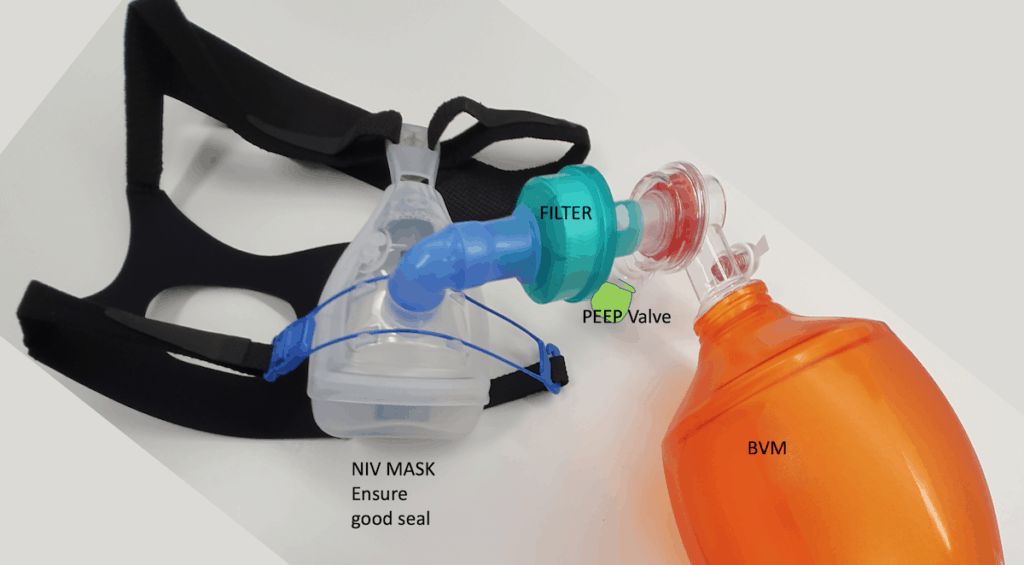
To help with the setup so that its more easily tolerated, my EMCORE buddy Adam Michael from Bundaberg hospital in Queensland sent me this setup.
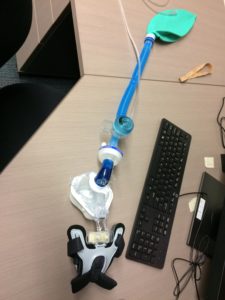
- It doesn’t contain a fish mouth valve (unlike a self inflating bag). The self inflating bag has a reasonable amount of resistance to flow during spontaneous breathing, which might contribute to fatigue in patients with respiratory failure, potentially worsening hypercapnoea.
- The circuit is typically used at 15L/min + for typical bag ventilation of a patient.
- As long as the flow rate is significantly higher than minute volume, there shouldn’t be too much CO2 rebreathing apart from what occurs in the deadspace between the mask and the PEEP valve
- The bag is 2L so wouldn’t typically be emptied by a spontaneously breathing patient, even in the setting of hyperventilation from viral pneumonitis/hypoxaemia, with the exception of deliberate large inspiratory volumes on the part of the patient.
- The device will deliver FIO2 of close to 1, but can’t be adjusted to deliver lower FIO2, unless we have access to a gas mixture which we could put in through the oxygen tubing. This is one of the limitations of the system.
- The APL valve works like a PEEP valve, but you don’t get a number for PEEP, you just adjust it it to patients work of breathing, SpO2, and the appearance of the bag. You can open the APL valve and add in a standard PEEP valve.
How about Bubble CPAP?
Milliner B et al produced a paper in the International Journal of Emergency Medicine, titled A pilot study of improvised CPAP (iCPAP) via face mask for the treatment of adult respiratory distress in low-resource settings.
They improvised a system of CPAP, using equipment commonly found in the emergency department. The system is shown below:
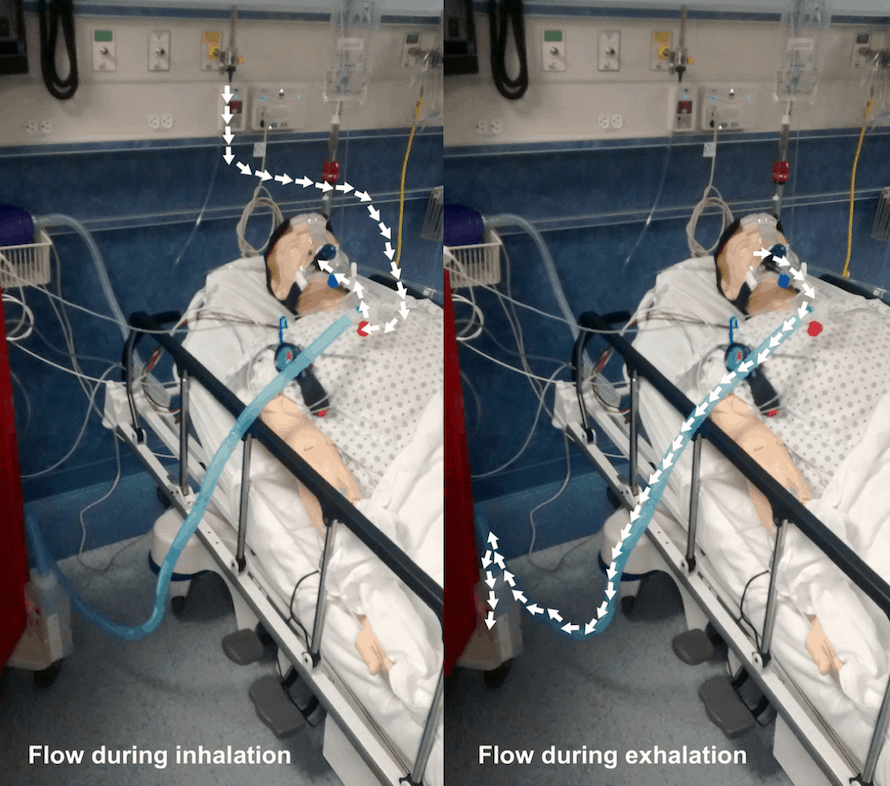
Hippo EM put together a working model of this:
What about Helmet CPAP?
We’ve seen the striking images from COVID-19 patients being treated in Italy, using CPAP helmets. I would initially have assumed that they would be quite claustrophobic and difficult to tolerate, however some patients do tolerate them well. In the Italian experience around 20% of patients were treated with these.
Below is a video how they work.
I’m sure someone is MacGyvering one of these. What better thing to use than a water cooler bottle?
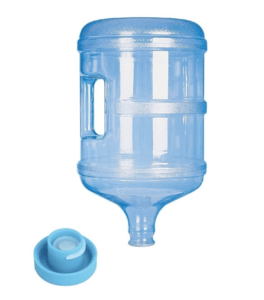
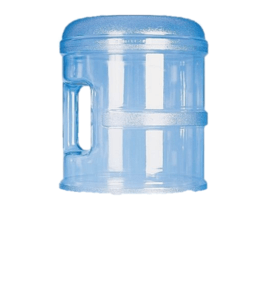
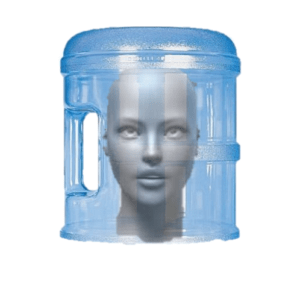
Well, it was a thought anyway.
Lot’s more to come.
SEND IN YOUR INVENTIONS and I’ll put them up.


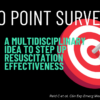








you’re actually a good webmaster. The site loading speed is incredible.
It kind of feels that you’re doing any unique trick.
Also, The contents are masterwork. you have done a
wonderful process in this topic!
I simply couldn’t leave your site prior to suggesting that I actually enjoyed the usual info an individual
provide on your visitors? Is gonna be back often to check out new posts
Why users still make use of to read news papers when in this
technological world all is available on web?
Spot on with this write-up, I absolutely believe that this
website needs much more attention. I?ll probably be
back again to see more, thanks for the info!
Review my blog: men skin
Link exchange is nothing else except it is simply placing the other person’s weblog link on your page at suitable place and
other person will also do same for you.
My family members all the time say that I am wasting my time here at net, however I know I am
getting experience every day by reading thes
good content.
Why people still make use of to read news papers
when in this technological globe the whole thing is existing on web?
I rattling thankful to find this internet site on bing, just what I was looking
for 😀 besides saved to bookmarks.
my web blog; https://keonicbdgummy.mystrikingly.com/ (keonicbdgummy.mystrikingly.com)
Hello.This post was extremely fascinating, especially because I was looking for thoughts on this matter last Tuesday.
My website; https://penzu.com/p/506a9904
This page really has all the information and facts I needed about this subject and didn’t know who
to ask.
For most recent information you have to pay a quick visit the
web and on the web I found this site as a finest web site for
most recent updates.
Also visit my site: https://cannabidiol-reviews.blogspot.com/2021/09/keoni-cbd-take-care-of-your-body.html; cannabidiol-reviews.blogspot.com,
For most recent information you have to pay a quick visit the web and on internet
I found this site as a most excellent site for hottest updates.